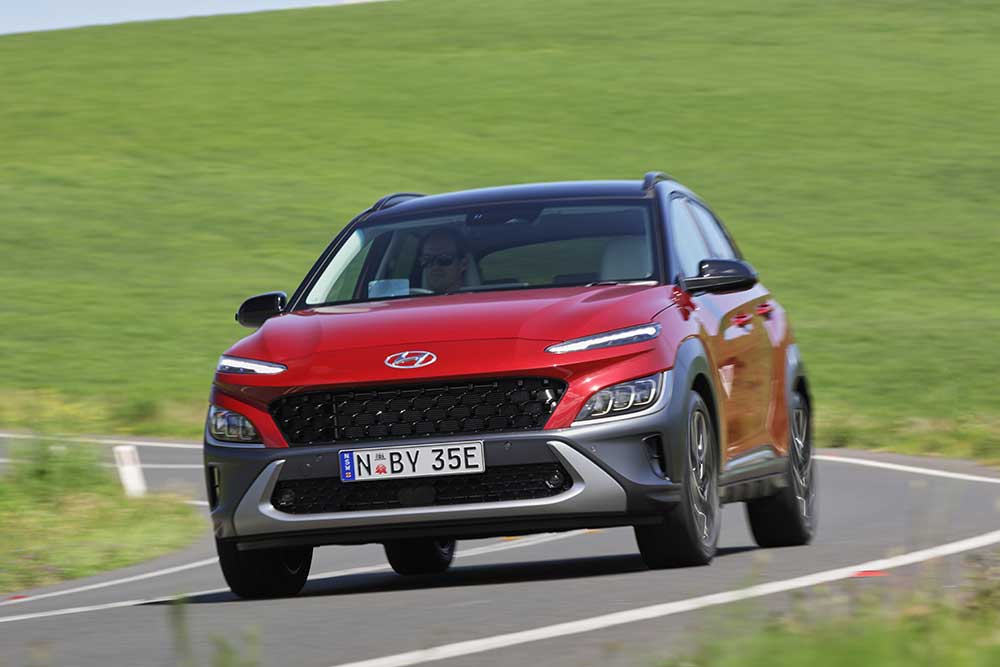Hyundai Kona Elite FWD and N Line Premium AWD review

Korean car maker Hyundai has given its popular Kona small SUV a comprehensive spruce up in a bid to keep it near the front of a hard-charging pack of rivals, that number no less than 24 and counting.
These latest updates deliver styling changes, extra standard comfort, and convenience features and additional Smartsense safety technologies to what is currently Australia’s second most popular small SUV, behind the Chinese-made MG ZS.
While the keenly priced MG has shown the entire pack a clean set of heels this year, the Kona is holding off concerted challenges from the Mazda CX-30 and the Mitsubishi ASX.
Reinforcements are coming, however, in the form of the much-anticipated Kona N performance version.
As part of the 2021 updates the Kona model range has been restructured, with Hyundai improving the affordability and accessibility of its electric models by introducing a new lower-output, lower-priced version (100kW/395Nm) termed Standard Range.
The latter is a reference to the EV’s claimed electric range of up to 305km (WLTP), with the new variant available in Elite ($54,500) and Highlander ($58,000) grades.
The established 150kW Kona EV models, with 484km quoted range, have been renamed Extended Range, with prices trimmed by $1,500 on the Elite ($60,500) and $2,000 on the Highlander ($64,000).
While the purchase price of Kona petrol models remains significantly lower than their electric counterparts, their prices have risen by between $1,000 and $2,300.

Despite this, Kona petrol vehicle prices still start from an affordable $26,600, and Hyundai points to the new model’s additional features as justification for the price rises.
Now, as before, there are four front-wheel-drive models – all powered by a 110kW 2.0-litre four-cylinder engine – beginning with the entry-level Kona (previously badged Go), followed by the Active, Elite, and Highlander.
However, buyers no longer have the choice of equivalent grades in the AWD range with the feistier 146kW 1.6-litre turbo petrol engine.
The line-up here now consists of the N Line ($36,300) and N Line Premium, both equipped with a seven-speed DCT (with rev-matching function on downshifts) instead of the CVT auto used in the less-expensive models.
Both the 2.0-litre and 1.6-litre turbo engines are tuned to run on regular 91 RON unleaded.
The new Smartstream 2.0-litre engine now uses Atkinson Cycle technology to improve its efficiency, with official combined cycle fuel consumption reduced by 14% to 6.2L/100km.
Together with a CVT auto that incorporates a manual mode and the ability to provide stepped shifts on harder acceleration to mimic the feel of a conventional auto, the new engine proves a willing performer.
Buyers looking for something more engaging will look to the N Line models, with the turbo engine feeling noticeably livelier thanks to its stronger 265Nm peak torque figure, maintained from 1,600 to 4,500rpm.

The engine’s power and torque have both been increased over the previous model, providing more oomph for overtaking and better matching the N Line’s enhanced chassis dynamics.
Grip levels are enhanced by 18-inch Continental Contact Sport tyres (versus the Elite’s 17-inch Nexen rubber) and all-wheel-drive.
Rounding out the N Line performance package are larger ventilated front disc brakes, promising improved braking performance, while all new Kona models have an electric park brake.
All models now boast alloy wheels, with new designs for Active and Elite versions, and an 18-inch machined-face design for the Highlander.
Exterior styling has been refreshed across the range, with new bumpers fore and aft, a new grille, revised lighting front and rear and a fresh take on Hyundai’s stacked headlamp design.
Highlander and N Line Premium models also benefit from multi-faceted reflector LED headlights.
Kona N Line versions come in for even more exclusive cosmetic touches to signify their higher price point and sports positioning.
This includes the interior, where both variants feature exclusive black leather with red stitching and other red highlights, plus specific logos on the front seats and shift lever.

Elsewhere, black cloth trim is standard on the entry-level Kona, while other grades score black leather, with optional two-tone beige leather on Highlander.
In terms of equipment levels, the base Kona gets standard Apple CarPlay and Android Auto connectivity via Wi-Fi (or optional cable for the latter), a revised 8.0-inch multimedia system, rear camera, tyre pressure monitoring, smart key system and a wireless smartphone charging pad.
The latter isn’t common at this price point, so a worthwhile point of difference.
Stepping up to the Elite buys an upgraded 10.25-inch satnav system, Harman Kardon premium audio, and climate control.
The N Line Premium’s extras include 10.25-inch digital instrument cluster, head-up display, heated, ventilated and power-adjustable front seats, heated rear outboard seats, heated steering wheel, cabin ambient lighting and glass sunroof.
There’s an extensive suite of Smartsense safety technologies across the range, which gets more generous the further you head up the model hierarchy.
Even the base model features forward collision avoidance assist, lane following assist, lane-keep assist, smart cruise control with stop and go function, rear occupant alert, driver attention warning and front, side, and curtain airbags.
There are, however, no centre front airbags on any of the updated Kona models.
Additional items on the Elite’s safety list include blind-spot collision avoidance, rear cross-traffic collision avoidance and a safe exit warning system.

Stepping up to the N Line Premium adds high beam assist and front park assist.
Warranty coverage is five years/unlimited kilometres and Hyundai’s lifetime service plan applies.
Kona N Line owners will be visiting the dealer more frequently though, with service intervals of 12 months/10,000km compared with 12 months/15,000km for the 2.0-litre models.
Individual service costs for both engines are $319.
Since its introduction in 2017, the Hyundai Kona has become one of the class’s most popular models and a major sales pillar for the Korean brand.
This latest refresh of the easy to drive and likeable small SUV should ensure it retains its position as one of the class leaders whilst offering an impressive all-round value proposition.
Key stats
- MLP: Elite $31,600; N Line Premium AWD $42,400.
- Engine: Elite 2.0-litre petrol 4 cyl; N Line Premium 1.6-litre turbo-petrol 4 cylinder.
- ANCAP crash rating: Five stars (2017) – all variants including electric.
- Fuel consumption (combined cycle, litres/100km): 6.2 (148 g/km CO₂) Elite; 6.9 (156g/km CO₂) N Line Premium.
- For: Improved equipment levels and safety, increased outputs from turbo engine, easy to drive and likable small SUV, N Line dynamics, EVs more affordable.
- Against: Space-saver spare, price rises, feistier turbo engine now reserved for N Line variants at higher cost, no centre front airbag.
Related topics
-
The information in this article has been prepared for general information purposes only and is not intended as legal advice or specific advice to any particular person. Any advice contained in the document is general advice, not intended as legal advice or professional advice and does not take into account any person’s particular circumstances. Before acting on anything based on this advice you should consider its appropriateness to you, having regard to your objectives and needs.
Insurance products (excluding Travel Insurance) are issued by RACQ Insurance Limited ABN 50 009 704 152 (RACQ). Conditions, limits and exclusions apply. This is general advice only and may not be right for you. This information does not take your personal objectives, circumstances or needs into account. Read the Product Disclosure Statement (PDS) and any applicable Supplementary PDS before making a purchase decision on this product. You can also access our Target Market Determinations on this website.
Banking and loan products issued by Members Banking Group Limited ABN 83 087 651 054 AFSL/Australian credit licence 241195 trading as RACQ Bank. Terms, conditions, fees, charges and lending policies apply. This is general advice only and may not be right for you. This information does not take your personal objectives, circumstances or needs into account. Read the disclosure documents for your selected product or service, including the Financial Services Guide and the Terms and Conditions, and consider if appropriate for you before deciding.
Except for RACQ Bank, any RACQ entity referred to on this page is not an authorised deposit-taking institution for the purposes of the Banking Act 1959 (Cth). That entity’s obligations do not represent deposits or other liabilities of RACQ Bank. RACQ Bank does not guarantee or otherwise provide assurance in respect of the obligations of that entity, unless noted otherwise.
RACQ Operations Pty Ltd (ABN 80 009 663 414 AR 000234978) and Members Travel Group Pty Ltd (ABN 45 144 538 803 AR 000432492) are acting as an Authorised Representative of the issuer of the insurance, Tokio Marine & Nichido Fire Insurance Co., Ltd. (ABN 80 000 438 291 AFSL 246 548). Any advice set out above is general in nature only, and does not take into account your objectives, financial situation or needs. Before purchasing any travel products, please consider the RACQ Travel Insurance Product Disclosure Statement (PDS) and the Target Market Determinations (TMDs) that apply to these products. Whilst the PDS outlines the Terms and Conditions of these products, the TMDs outline the intended class of customers that comprise the target market for these travel products. This will allow you to consider which products best suit your objectives, financial situation and needs and consider the products appropriateness to your personal circumstances. TMDs also outline matters involving the distribution and the review of these products. The PDS, Supplementary PDS and TMDs for each travel product can be found here.
